Class Society
-
- El Faro and Perceived Deficiencies in the ACP Maritime Reporter, Dec 2017 #12
The October 1, 2015 loss of the U.S. cargo vessel El Faro along with its 33 member crew led to the convening of a Coast Guard Marine Board of Investigation charged with determining as closely as possible the cause(s) of the casualty; whether there is evidence that any failure of material was involved; whether there is evidence of misconduct, inattention to duty, negligence, or willful violation of law; and whether there is evidence that government personnel contributed to the casualty. The Marine Board released its report on October 1, 2017, the second anniversary of the casualty.
The Marine Board’s report, which is not final until approved by the Commandant, found no single cause for this tragic event. Rather, as in most such incidents, there were numerous factors that combined in the fatal voyage of El Faro from Jacksonville to San Juan in 2015. This article will only focus on one of those factors: perceived deficiencies in the USCG Alternative Compliance Program.The Alternative Compliance Program (ACP) is a protocol whereby the U.S. Coast Guard delegates to an authorized classification society (ACS) the authority to perform specific inspections of U.S.-flag vessels on its behalf. The ACP was initiated in the mid-1990s in response to complaints by ship owners and operators that their ships were undergoing duplicative inspections by the U.S. Coast Guard and surveys by classification societies that resulted in unnecessary delays in ship schedules.On January 12, 1995, the Coast Guard and the American Bureau of Shipping (ABS) signed a memorandum of understanding (MOU) to establish a pilot program for an alternative to certain traditional Coast Guard vessel inspections. Owners and operators of certain ABS-classed, Coast Guard inspected vessels were invited to participate. This was followed by publication of a proposed rulemaking on June 22, 1995 and promulgation of an interim final rule on December 27, 1996. The interim final rule expanded the ACP to all qualifying classification societies. It should be noted that this rulemaking was completed in near-record time, evidencing the tremendous pressure being exerted on the Coast Guard by the maritime industry.Under the ACP, each ACS worked with the Coast Guard to develop a “U.S. Supplement” identifying those inspection items and standards required by the Coast Guard that were absent from or treated differently by the classification society’s rules. The U.S. Supplement for each ACS is required to be updated annually and procedures were established to provide for this. When an ACS surveyor was conducting an inspection on behalf of the Coast Guard, the surveyor was obligated to utilize the U.S. Supplement as applicable.Unfortunately, the ACP appears to have lost its significance as it became routine. The Coast Guard billet for Liaison Officer for the Recognized and Authorized Class Societies (LORACS) was eliminated in 2012. Coast Guard marine inspectors originally conducted their annual overview inspections of ACP participating vessels in conjunction with ACS surveyors to ensure that their mutual understandings of USCG requirements were aligned. These joint inspections atrophied over time and became the exception rather than the rule. Class societies and their surveyors were not held accountable for substandard ACP inspections. Following the 2015 loss of the US cargo ship El Faro, the Coast Guard Traveling Inspector Staff conducted oversight inspections of a number of vessels participating in the ACP. It became clear that multiple ACP vessels had been operating for prolonged periods in a substandard material conditionThe Alternative Compliance Program did not directly cause the loss of El Faro. It was, though, a contributing factor due to various deficiencies identified during the Marine Board’s investigation.El Faro was enrolled in the ACP on February 27, 2006. The Marine Board identified various points at which the ACP is not operating as envisioned.At the time of the El Faro casualty, the applicable U.S. Supplement had last been updated in April 2011, making it four years out of date.The majority of inspections, surveys and examinations of El Faro were conducted by either the class society surveyors or Coast Guard marine inspectors; they were rarely conducted by both at the same time. It should be noted that ACP policy did not require a minimum level of Coast Guard oversight exams to be conducted in conjunction with an authorized class society (ACS) inspection.El Faro did not conduct required underway operational tests of its lifeboats during the last inspection for certification prior to the accident voyage. At the time of the last inspection, ACP policy dictated that the Coast Guard was responsible for observing the operational lifeboat tests in the water and assessing the crew’s performance during those tests, which were supposed to be conducted during the ACP oversight examination. The authorized class society did not identify any concerns related to lifesaving gear or drills after conducting the last compliance survey on El Faro nor did it require launching or witness the lifeboats operating in the water.As a result of being enrolled in the ACP, El Faro and its company (TOTE) were required to be in compliance with the International Safety Management (ISM) Code. This required, among other things, a Safety Management System (SMS). TOTE’s Emergency Response Manual (ERM) under the SMS did not contain information related to any operational safety-related emergencies including adverse weather, flooding, loss of stability, cargo shifting, or abandon ship. Neither Coast Guard marine inspectors nor class society surveyors identified any deficiencies in the El Faro SMS during the last ACP examinations of the vessel.Other shortfalls in the ACP identified by the Marine Board include:- The ACP training course for ACS surveyors and Coast Guard marine inspectors to interact and become familiar with the program never materialized.
- ACS surveyors and Coast Guard marine inspectors are often unfamiliar with the program requirements and the U.S. Supplement.
- There is no minimum qualification level required for Coast Guard marine inspectors to conduct ACP oversight exams.
- The Coast Guard does not require marine inspectors to be trained as auditors.
- Classification society training requirements for certain inspection activities (e.g., overseeing repairs to a propulsion steam boiler) are far less than the Coast Guard would require for a marine inspector conducting a similar inspection activity.
- ACS surveyors performing ACS inspections are reluctant to hold up a commercial vessel especially for observations that are outside the scope of the classification society survey being performed.
- The ACP does not have a designated lead office or individual at Coast Guard Headquarters.
The Marine Board Report of Investigation (ROI) makes various recommendations with regard to the Alternative Compliance Program including the following:- Use of U.S. Supplements should be eliminated and ACS surveyors should default to the 46 CFR requirements.
- ACS accountability and transparency should be increased through annual Coast Guard reports of domestic vessel compliance, including certain control actions associated with an ACS.
- Individual ACS surveyors should be vetted by the cognizant Coast Guard Officer in Charge of Marine Inspection (OCMI) for each type of delegated activity being conducted on behalf of the Coast Guard.
- The Coast Guard should develop and add to the curriculum for training marine inspectors an Advanced Journeyman Inspector course covering ACS oversight, auditing responsibilities, and inspection of unique vessel types.
- The Coast Guard should consider creation of a Third Party Oversight National Center of Expertise to conduct comprehensive and targeted oversight activities on all third party organizations and ACSs that perform work on behalf of the Coast Guard.
I think that the Marine Board did an excellent job of analyzing the circumstances surrounding the tragic loss of El Faro. I am also concerned with the various shortcomings in the Alternative Compliance Program identified in the Report of Investigation. I concur with some, but not all, of the Marine Board’s recommendations.The Alternative Compliance Program clearly needs to be tightened. Improved Coast Guard oversight and accountability is vital. I do not, though, think that the U.S. Supplements should be jettisoned. Classification surveyors are trained to check for conformity with class society rules. They are not intimately familiar with 46 CFR, even though the two systems largely cover the same items. The USCG regulations include numerous cross references that may be lost on the uninitiated. A proper U.S. Supplement developed and approved by the Coast Guard and the ACS and kept up-to-date will be more useful to a surveyor than a set of Coast Guard regulations. While the Coast Guard needs to do a better job of auditing ACS exams and holding class societies accountable, it is unnecessary in my opinion to publicly list such exam deficiencies. The Coast Guard can and should, though, issue warning letters to an ACS found to have a pattern of deficiencies and remove the ACP authorization when appropriate.The Alternative Compliance Program can provide a valuable service to the marine industry and the Coast Guard, but only if it operates as intended. The El Faro tragedy highlighted certain deficiencies in the program and the Marine Board has made some valuable recommendations for improving the process. It is now up to the Coast Guard and the classification societies to improve the process. The Coast Guard and the class societies recently conducted a summit to address issues identified in the Marine Board report and get this important program back on track.The AuthorDennis L. Bryant is with Bryant’s Maritime Consulting, and a regular contributor to Maritime Reporter & Engineering News as well as online at MaritimeProfessional.com.t: 1 352 692 5493(As published in the December 2017 edition of Maritime Reporter & Engineering News) -
- Partnerships Drive SubChapter M Solutions Marine News, Mar 2017 #32
they’ll need to decide whether they want help navigating the new regulations. If so, are they better off with a team approach or sticking with a single class society? And is a retrofit experienced blue water approach acceptable or would a built-from-the-ground-up brown water application be the better solution
-
- The Day of the Unmanned Ship is Dawning Maritime Reporter, Apr 2018 #50
the way shipping works. And as operations are digitalized, they become more automated, Dr. Pierre C. Sames, Director of Group Technology & Research at class society DNV GL, has stated.Governments around the world are looking into unmanned shipping as a way to move more cargo to sea in order to contain the spiraling
-
- Autohydro: User-friendly Engineering Software for Class Approval Marine News, Mar 2021 #37
Strength software to analyze and solve,” he said, adding, “to date, all of BMD’s stability books have been approved by the designated class society, including ABS1.”ASC has worked closely and cooperatively with BMD to deliver on-time, complete engineering packages for workboats, pushboats
-
- BV Proposes 12,500-TEU Mega Containership Maritime Reporter, Jun 2001 #92
new designs. At capacities over 10,000 teu, conventional designs cannot be maintained. It is a challenge for the whole shipping industry. As a class society, we try to ensure safety by assessing and solving any potential difficulties in advance." BV's mega containerships would have a scantling draft
-
- Staying Grounded About Electrification Marine News, Jan 2022 #12
standards, critical to their long-term uptake within the industry.Adhering to the design and installation requirements of the vessel’s flag state, class society or both, may be required and is critical to maintaining and improving the safety of lithium-ion battery installations. These design and regulatory
-
- Exceptional (Market) Reach Lifts a Crane Retrofit to Success Marine News, Jun 2019 #30
custom designs – all to any of the well known rules, including but not limited to FEM, ABS, DNV, BV, NK, RINA, API, and the firm certifies to any major class society. Customized, special options can be provided, as well. These include hazardous zone operation systems (ATEX); Active Heave Compensation systems
-
- Get Started! Benefits, Advice Abound for SMS Laggards Marine News, Sep 2015 #38
in an SMS, so that’s a pretty good starting point.” SMS tutorials and webinars are another option. One such example is the Subchapter M seminar run by class society ABS and its sister company ABS Group. Ian McVicker, towing vessel coordinator for ABS Group, who gives a soup-to-nuts presentation on the subject
-
- Castor's Downfall: Hyper-Accelerated Corrosion Maritime Reporter, May 2001 #18
that our interpretation of events is correct," said larossi. "The Castor represents an unprecedented level of cooperation between the class society and the Flag State involved in a casualty," said Captain Andreas Constantinou, senior marine surveyor for the Cyprus Department of Merchant Shipping
-
- Ballast Water Treatment Modular and Just in Time Maritime Reporter, Aug 2015 #34
might recognize that the IMO is the only way to go. Why wait while we pollute as much as we can.” Yet, it is understood DNV GL, the German-Norwegian class society, has been contributing to the USCG’s growing list of ballast water rules. In an interview with Maritime Reporter on the central stage of a Nor-Shipping
-
- ABS: Sharpening its Global View Maritime Reporter, May 2016 #34
to do its job more efficiently in coming years. “Technology will enable us to do our job better,” said Tikka. “But the one difference that we as a class society need to keep in mind compared to organizations that use data to target certain markets or develop new products, when we use data, we use it to
-
- In Big Ship Fuel Economy, Finances Trump Regulation Maritime Reporter, May 2013 #54
conference, you floated the notion of self regulation for the maritime industry. Is this a reality, and what would be the driver? Being with a class society, we are part of the industry which to a large extent is self-regulating. If you think of the class rules, it is self regulation for the industry
-
 )
March 2024 - Marine Technology Reporter page: 40
)
March 2024 - Marine Technology Reporter page: 40of range of subsea assets such as Remotely Operated Towed Ve- 2,500 Nm and a unique naval architecture that enables the USV hicles (ROTVs), inspection-class Remotely Operated Vehicles to withstand the most severe ocean conditions, the new DriX (ROVs), as well as Autonomous Underwater Vehicles (AUVs).
-
 )
March 2024 - Marine Technology Reporter page: 34
)
March 2024 - Marine Technology Reporter page: 34, sheet for the discharge graphs. to increase current capacity, or both. Many batteries have a self-discharge rate, which means There are two broad classes of batteries, primary and second- that even on the shelf under no load, the cell’s reactants will ary. Primary cells can be used once, as the chemical
-
 )
March 2024 - Marine Technology Reporter page: 27
)
March 2024 - Marine Technology Reporter page: 27SEA-KIT USV Maxlimer returning from HT-HH caldera in Tonga. © SEA-KIT International data and further assess ecosystem recov- ery. What is known, noted Caplan-Auer- bach, is that the impact of submarine vol- canoes on humans is rare. “The HT-HH eruption was a tragedy, but it was very unusual. It let us
-
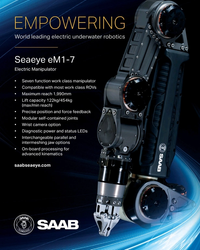 )
March 2024 - Marine Technology Reporter page: 3
)
March 2024 - Marine Technology Reporter page: 3EMPOWERING World leading electric underwater robotics Seaeye eM1-7 Electric Manipulator • Seven function work class manipulator • Compatible with most work class ROVs • Maximum reach 1,990mm • Lift capacity 122kg/454kg (max/min reach) • Precise position and force feedback • Modular self-contained
-
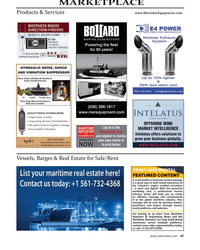 )
April 2024 - Maritime Reporter and Engineering News page: 47
)
April 2024 - Maritime Reporter and Engineering News page: 47??AYElSG DA?sOwGEGl?Ž?UÐAYSGuÐd?suEd?AYE A?A?GYG??AÐ?Ž??w?uOÐuGÐuA?Ž?w?? ÐŽYlAÐl?Ž???AuG??GÐ?G?GYlAO|GlŽEA?? Ž?ÐAuu???????????????? www.marinelink.com 47 Class MR Apr2024.indd 47 4/1/2024 3:42:27 P
-
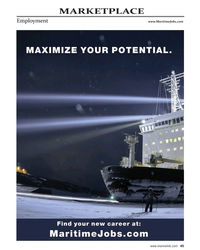 )
April 2024 - Maritime Reporter and Engineering News page: 45
)
April 2024 - Maritime Reporter and Engineering News page: 45MARKETPLACE Employment www.MaritimeJobs.com www.marinelink.com 45 Class MR Apr2024.indd 45 4/1/2024 1:02:04 PM
-
 )
April 2024 - Maritime Reporter and Engineering News page: 43
)
April 2024 - Maritime Reporter and Engineering News page: 43“The industry is an ecosystem which includes owners, managers, mariners, shipyards, equipment makers, designers, research institutes and class societies: all of them are crucial,” – Eero Lehtovaara, Head of Regulatory & Public Affairs, ABB Marine & Ports All images courtesy ABB Marine and Ports provi
-
 )
April 2024 - Maritime Reporter and Engineering News page: 42
)
April 2024 - Maritime Reporter and Engineering News page: 42to follow. shipyards, equipment makers, designers, Today, ships are ? lled with standalone With all levels of society increas- research institutes and class societies: all proprietary technologies. Two systems op- ingly reliant on digital technology, the of them are crucial,” said Lehtovaara. erating
-
 )
April 2024 - Maritime Reporter and Engineering News page: 41
)
April 2024 - Maritime Reporter and Engineering News page: 41on board but to provide ment for Products and Solutions from ages is automatically triggered, so Groke them with the best possible information Japanese classi? cation society ClassNK, Pro provides an irrefutable evidence trail to support their decision-making. With a timely achievement. With increasing
-
 )
April 2024 - Maritime Reporter and Engineering News page: 38
)
April 2024 - Maritime Reporter and Engineering News page: 38U.S. markets to Nicaragua, Hon- duras, Guatemala and El Salvador. Each ship will feature 300 Image courtesy HRDD refrigerated unit plugs. The four Avance-class ships are named after national birds, archaeological sites and lakes in Central lassNK granted its “SCCS-Full” class notation to America, Crowley
-
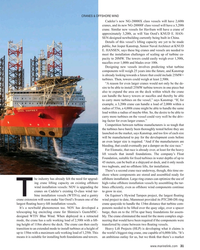 )
April 2024 - Maritime Reporter and Engineering News page: 31
)
April 2024 - Maritime Reporter and Engineering News page: 31CRANES & OFFSHORE WIND Cadeler’s new NG-20000X class vessels will have 2,600t cranes, and its new NG-20000F class vessel will have a 3,200t crane. Similar new vessels for Havfram will have a crane of approximately 3,200t, as will Van Oord’s KNUD E. HAN- SEN-designed newbuilding currently being built in
-
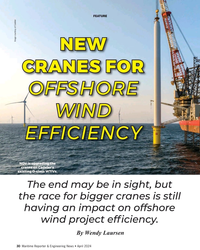 )
April 2024 - Maritime Reporter and Engineering News page: 30
)
April 2024 - Maritime Reporter and Engineering News page: 30FEATURE Image courtesy of Cadeler NEW CRANES FOR OFFSHORE WIND EFFICIENCY NOV is upgrading the cranes on Cadeler’s existing O-class WTIVs. The end may be in sight, but the race for bigger cranes is still having an impact on offshore wind project ef? ciency. By Wendy Laursen 30 Maritime Reporter
-
 )
April 2024 - Maritime Reporter and Engineering News page: 28
)
April 2024 - Maritime Reporter and Engineering News page: 28Fleet ? agship, USS Mount Whit- ney, that has a combined civil service and military crew. Our two ocean going tugs are going to be part of a 10-ship class. We have a special warfare support ship; two high-speed transports; and the high-speed expeditionary fast transport, of which 14 are now in service
-
 )
April 2024 - Maritime Reporter and Engineering News page: 27
)
April 2024 - Maritime Reporter and Engineering News page: 27Logistics Force will be familiar to our Surface detailed world-wide, although some ships like EPF require Force Sailors. We have 14 Henry J. Kaiser-class ? eet replen- high-speed craft (HSC) training. So, MyMSC will help track ishment oilers and three of the new John Lewis class of ? eet and manage
-
 )
April 2024 - Maritime Reporter and Engineering News page: 26
)
April 2024 - Maritime Reporter and Engineering News page: 26FEATURE INTERVIEW “Over the next decade, 12 new classes of ships will come online and MSC will see up to 20 new ships deliver to the ? eet in the next ? ve years. This includes new oilers, towing, salvage and rescue tugs, and expeditionary fast transports and emergency medical ships. A large
-
 )
April 2024 - Maritime Reporter and Engineering News page: 25
)
April 2024 - Maritime Reporter and Engineering News page: 25To start, we are building new and material--from the U.S. to where ships. Over the next decade, 12 new it’s needed, most of that will move by classes of ships will come online and sea. One of our larger sealift vessels can MSC will see up to 20 new ships deliver to carry the equivalent of 30
-
 )
April 2024 - Maritime Reporter and Engineering News page: 21
)
April 2024 - Maritime Reporter and Engineering News page: 21marine industry,” said Langford. “We continue to hire key in- oil and gas platforms, the holy grail of rigorous dividuals and partner to provide best-in-class solutions.” R conditions in offshore energy production. From Also – like most companies in the maritime and offshore that start he – like most other
-
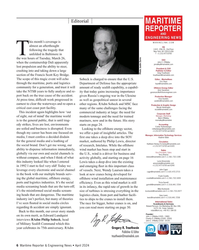 )
April 2024 - Maritime Reporter and Engineering News page: 6
)
April 2024 - Maritime Reporter and Engineering News page: 6into the existing [email protected] +1.212.477.6700 ext 6240 in 1992 I start to feel very old! Today we and emerging ? eet in this important class John Cagni leverage every electronic and social channel of vessels. Next, Wendy Laursen takes a [email protected] | +1.631.472.2715 in the
-
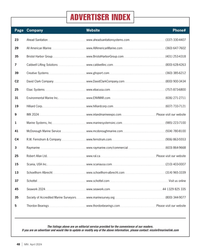 )
April 2024 - Marine News page: 48
)
April 2024 - Marine News page: 48ADVERTISER INDEX Page Company Website Phone# 23 Ahead Sanitation www.aheadsanitationsystems.com (337) 330-4407 29 All American Marine www.AllAmericanMarine.com (360) 647-7602 35 Bristol Harbor Group www.BristolHarborGroup.com (401) 253-4318 7 Caldwell Lifting Solutions www.caldwellinc.com (800)
-
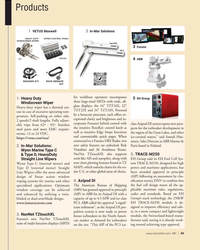 )
April 2024 - Marine News page: 43
)
April 2024 - Marine News page: 43clarity and brightness and in- 2 speeds/2 shaft lengths. Fully adjust- able wipe from 62º - 92º. Stainless corporate Furuno’s hybrid control with class Azipod DI system opens new pros- the intuitive RotoKey control knob as pects for the icebreaker development in steel parts and meet EMC require- well
-
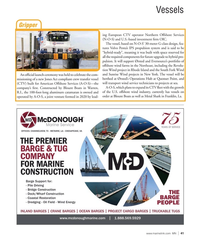 )
April 2024 - Marine News page: 41
)
April 2024 - Marine News page: 41Vessels Gripper ing European CTV operator Northern Offshore Services (N-O-S) and U.S.-based investment ? rm OIC. The vessel, based on N-O-S’ 30-meter G-class design, fea- tures Volvo Penta’s IPS propulsion system and is said to be “hybrid-ready”, meaning it was built with space reserved for all the required
-
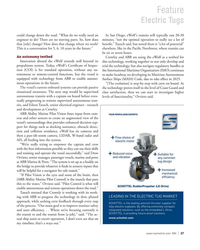 )
April 2024 - Marine News page: 37
)
April 2024 - Marine News page: 37systems can provide passive the technology proves itself to the level of Coast Guard and situational awareness. The next step would be supervised class satisfaction, then we can start to investigate higher autonomous transits with a captain on board before even- levels of functionality,” Orvieto said
-
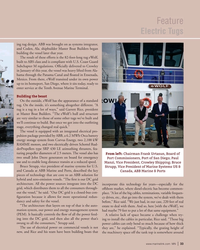 )
April 2024 - Marine News page: 33
)
April 2024 - Marine News page: 33, Ala. shipbuilder Master Boat Builders began building the vessel later that year. The result of these efforts is the 82-foot-long tug eWolf, built to ABS class and is compliant with U.S. Coast Guard Subchapter M regulations. Of? cially delivered to Crowley in January of this year, the vessel was heavy lifted
-
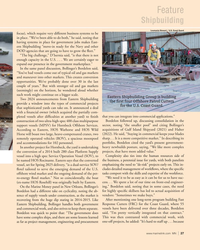 )
April 2024 - Marine News page: 27
)
April 2024 - Marine News page: 27vessels after dif? culties at another yard) to ? nish that you can integrate into commercial applications.” construction of two ultra-high-spec 400 class multipurpose Bordelon followed up, discussing consolidation in the support vessels (MPSV) for Hornbeck Offshore Services. sector, noting “the smaller
